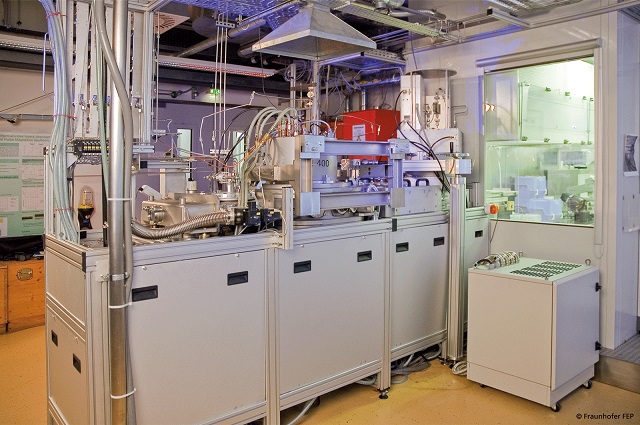 Fraunhofer researchers are using this lab coater to produce piezoelectric AlN layers for low power sensors in an economically feasible manner. © Fraunhofer FEP.
Fraunhofer researchers are using this lab coater to produce piezoelectric AlN layers for low power sensors in an economically feasible manner. © Fraunhofer FEP.
Researchers at the Fraunhofer Institute for Organic Electronics, Electron Beam and Plasma Technology FEP (Fraunhofer FEP) have developed an innovative process for cost-effective production of piezoelectric materials for micro-energy harvesting applications. Developments in many applications require energy self-sufficient probes and miniature mobile electronics systems that acquire the energy they need from the surrounding environment.
The supply of power for sensors through wires or batteries, in locations where there are space constraints, is often complicated. This can be addressed by integrating energy intake and producing power onsite using piezoelectric, thermoelectric materials and solar cells.
Piezoelectric materials have the ability to generate electric energy from mechanical vibrations. They can be used in places where vibrations occur, such as on engines, industrial equipment and on the human body. The heartbeat, breathing and blood pressure in the body cause vibrations that can be harvested. So far, leadzirconium- titanium composites (PZT) and aluminum nitride (AlN) have been used as piezoelectric materials. AlN demonstrates better properties as it is biocompatible, lead-free and can be used in existing processes for producing microelectronics.
Smaller piezoelectric materials are needed for smaller microelectrical systems. However, these materials require a specific volume for production of the needed energy. So far, researchers have not been able to cost-effectively produce targeted piezo coatings. Existing methods to produce targeted piezo coatings deliver very small coating areas, homogeneity and deposition rates and are also not economical.
The new method developed at Fraunhofer enables precipitation of highly homogeneous layers on products having up to 200mm diameter. Further, it enables high deposition rates, while being more economically feasible and productive.
The piezo coatings were made using a double ring magnetron sputter source for reactive magnetron sputtering of aluminum targets onto a silicon wafer. This deposition was made in an argon-nitrogen atmosphere and it enabled homogeneous deposition of AlN layers.
Fraunhofer FEP researchers collaborated with Oulu University in Finland, and the Technical University of Dresden to test energy harvesting using AlN coatings on silicon strips. The study reveals the feasibility of AlN layers for low-power sensors. Further, usage of aluminum-scandium-nitride layers provides better piezo-coefficients that enable more power production.
The researchers will unveil a demonstration model at the Electronica trade show in Munich this year.
References